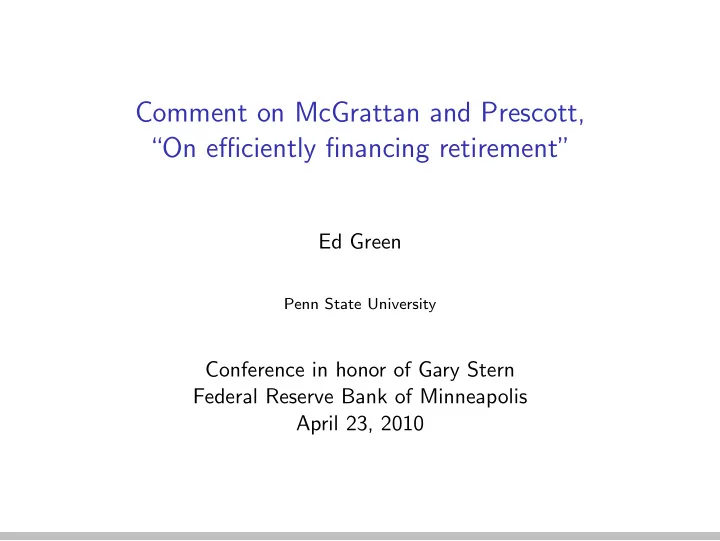

Comment on McGrattan and Prescott, “On efficiently financing retirement” Ed Green Penn State University Conference in honor of Gary Stern Federal Reserve Bank of Minneapolis April 23, 2010
Apology I’m a consumer–not a doer–of RBC macro/public finance. • I’ll raise some questions about what Ellen and Ed have done, but I can’t provide an alternative calibration. I haven’t previously studied Ellen and Ed’s research on accounting for capital–I’m still absorbing the details of it. I’ll briefly discuss their research, then make some remarks about the topic of their work.
Background: Should capital be taxed less? Older research: Eliminating capital taxation might significantly increase welfare. • E.g., Judd (1985), Chamley (1986) Lucas (1990). Recent, quantitative research: U. S. capital tax level (36%) is not far from optimal. • Imrohoroglu (1993, OLG model with constrained households facing income risk) • 10% rate is optimal. • Welfare gain from moving to this rate is only 1% (vs. 6% found by Lucas). • Aiyagari (1994, Bewley model): • Reasonable assumptions can justify either the current level or a low level. • Higher-than-U. S. levels can be justified under assumptions that are not crazy.
• Conesa, Kitao and Krueger (2008, OLG model with hegerogeneous, risk-exposed, financially constrained households) • Optimal capital tax level is 36%. • “[E]ndogenous labor supplied differentially over the life cycle is crucial. . . ” These results seem robust to assumptions about retirement finance. • Ayagari’s Bewley-style model has no retirement. • Imrohoroglu assumes that private savings finances retirement. • Conesa et al. assume an exogenous, balanced-budget, SS system.
What Ellen and Ed do Ellen and Ed Find a large (7.7–9.7%) gain in welfare from eliminating capital taxation (and eliminating SS). How do they get it? 1 Specify a model environment in which SS reduces welfare. 2 Reduce government expenditure instead of substituting labor-tax financing. • Specifically, eliminate SS. 3 Impute 46% instead of 30% share of income to capital. • Take account of intangible capital. 4 Consider an alternate demographic assumption that people live longer but do not work longer.
What Ellen and Ed don’t do: Eliminate capital tax and SS separately SS is currently funded by a tax on labor. Here’s a combination of policy changes that is unlikely to be legislated soon: 1 Eliminate Social Security; 2 Retain the SS tax and the current labor income tax; 3 Eliminate the tax on capital. But this is what Ellen and Ed study!
Why not study this, instead? Find a collection of federal expenditures that • Aggregate to the same amount as SS expenditure, and • Are arguably provided nearly efficiently. Consider the following policy combination: • Eliminate capital taxation; • Eliminate these expenditures; • Retain Social Security Then we would understand how much welfare gain comes from eliminating a tax distortion, versus from eliminating welfare-reducing (in their environment) expenditure.
Diamond’s efficiency criterion applied to the United States Ellen and Ed appeal to research by Abel et al. (1989) to justify a parameterization that makes SS inefficient. Abel et al. implement Diamond’s (1965) criterion in a way that avoids some specification issues. • E.g., what is the depreciation rate? However, Abel et al. assume a stationary capital stock.
Was the U. S. capital stock stationary in their sample period (1950–85)? • Plausibly—but not unquestionably—it was declining. • In 1950, K was above steady state for recent war production. • In 1974–85, I was abnormally low because of energy shocks and recession. • To impute a large decline, fast depreciation might have to be assumed. If K/L declined during the sample period, then the Abel et al. evidence may be consistent with satisfaction of Diamond’s criterion for SS to be efficient.
Further considerations regarding SS Income risk and financial constraints for households imply that Diamond’s criterion is too tight. (Miyazaki, 2010) • Without SS, households may over-accumulate K for precautionary saving. • I don’t know whether this effect is quantatively important. If parents’ welfare enters childrens’ utility functions, then Ricardian-equivalence questions arise. • Abstracting from tax distortion, private versus public funding of parents’ consumption might not matter. • SS is a subsidy from several-child to single-child families. • In principal, SS might reduce population growth.
Recommend
More recommend